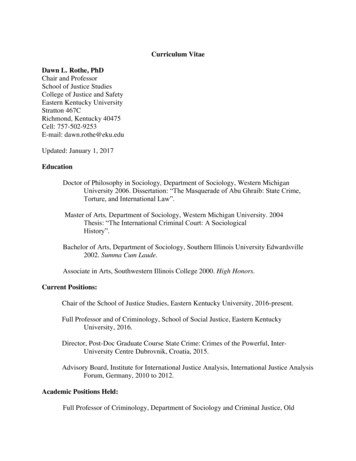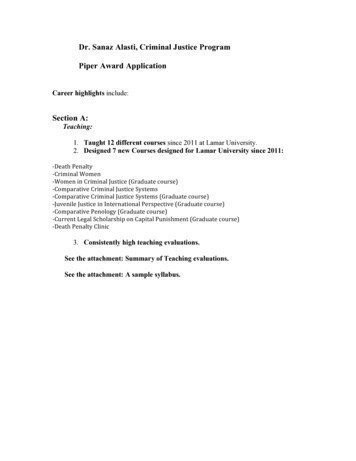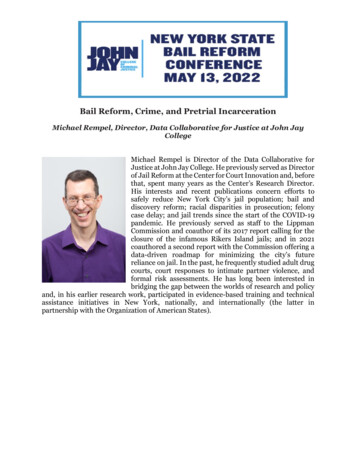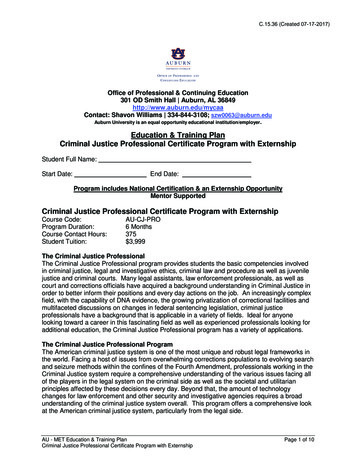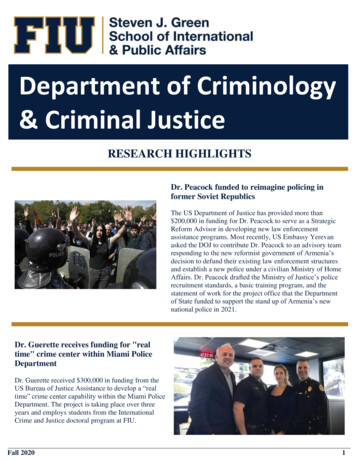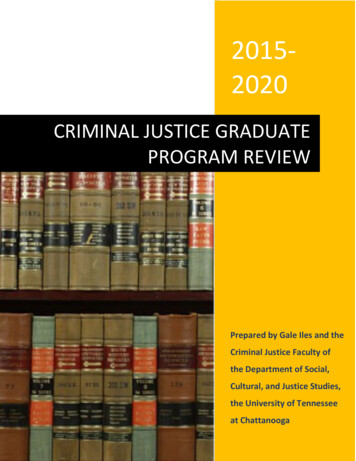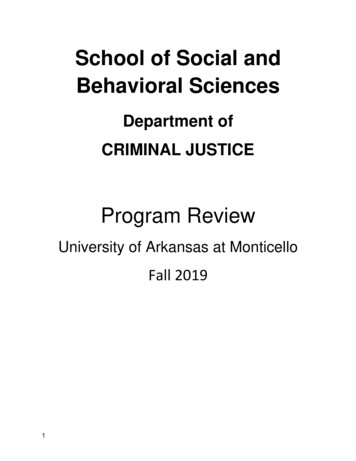
Transcription
School of Social andBehavioral SciencesDepartment ofCRIMINAL JUSTICEProgram ReviewUniversity of Arkansas at MonticelloFall 20191
Table of ContentsGoals, Objectives, and Activities1. Specific educational goals, objectives, and activities of the program.2. Explain how the program serves the general education program and otherDisciplinary programs on the campus, if applicable.3. Document market demand and/or state/industry need for careers stemming fromthe program.4. Document student demand for the program.5778Curriculum1. Describe how program content parallels current thinking/trends in the field/trade (best 9practices, advisory committee recommendations, etc.).2. Provide an outline for each program curriculum, including the sequence of courses.143. State the degree requirements, including general education requirements, institutional, 15college or school requirements, and major requirements.4. Indicate the semester/year the major/program courses were last offered.Exclude general education courses.195. Provide syllabi for discipline-specific courses and departmental objectives for eachcourse.226. Outline the process for the introduction of new courses, including all internalreview processes and the findings227. List courses in the proposed degree program currently offered by distance delivery.248. Describe the instructor-to-student and student-to-student interaction for distancecourses (prerequisite courses, lab requirements, examinationprocedures-online/proctored instructor response to student assignments).25Program Faculty (full-time/adjunct/part-time)1. Provide curriculum vitae or program faculty information form for all full-time program faculty.The vita or form should include the following: all degrees and institutions granting thedegrees; field or specialty of degrees; number of years employed as program faculty at theinstitution; current academic rank, if applicable; professional certifications/licenses; evidenceof quality and quantity of creative and scholarly/research activity; evidence of quality andquantity of service activities; evidence of professional activities and non-teaching workexperiences related to courses taught; list of course numbers/course titles of credit coursestaught over the past two academic years; and other evidence of quality teaching.272. Indicate the academic credentials required for adjunct/part-time faculty teachingmajor/program courses.283. Describe the orientation and evaluation processes for faculty, including adjunct andpart-time faculty.284. Provide average number of courses and number of credit hours taught for full-timeprogram faculty for current academic year.442
Program Resources1. Describe the institutional support available for faculty development in teaching,research and service.2. Describe the professional development of full-time program faculty over the pasttwo years including the institutional financial support provided to faculty for theactivities.3. Provide the annual library budget for the program or describe how library resourcesare provided for the program.4. Describe the availability, adequacy, and accessibility of campus resources(research, library, instructional support, instructional technology, etc.).5. Provide a list of program equipment purchases for the past three years.4545.464647Majors/Declared Students1. State the number of undergraduate/graduate majors/declared students in each degreeprogram under review for the past three years.482. Describe strategies to recruit, retain, and graduate students.483. Provide the number of program graduates over the past three years.49Program Assessment1. Describe the program assessment process and provide outcomes data(standardized entrance/placement test results, exit test results, etc.).2. Describe program/major exit or capstone requirements.3. Provide information on how teaching is evaluated, the use of student evaluations,and how the results have affected the curriculum.4. Provide transfer information for major/declared students including the receivinginstitutions for transfer and programs of study.5. Provide information for program graduates continuing their education by enteringgraduate school or by performing volunteer service.6. Provide aggregate results of student/alumni/employer satisfaction surveys.7. Describe how the program is aligned with the current job market needs of the stateor local communities.8. Provide job placement information for program graduates including the numberof graduates placed in jobs related to the field of study.Program Effectiveness (strengths, opportunities)1. List the strengths of the program.2. List the areas of the program most in need of improvement.3. List program improvements accomplished over the past two years.4. Describe planned program improvements, including a timetable and the estimatedcosts. Identify program improvement priorities.Appendices350515253.5454555555575758
Goals, Objectives, and Activities1. Describe specific educational goals, objectives, and activities of theprogram.The criminal justice program is part of the School of Social and Behavioral Sciences (SSBS) atthe University of Arkansas at Monticello (UAM). The program shares many goals with theSchool of Social and Behavioral Sciences and with the University at large. These include thedevelopment and dissemination of knowledge to improve society and the intellectual and socialdevelopment of individual students.The School of Social and Behavioral Sciences is guided by the following Student LearningObjectives (SLOs).(1)Research: Comprehensive research skills (both qualitative and quantitative) related tothe study of social and behavioral sciences, including the use of appropriate technologies andmethodologies to gather, analyze, and communicate research data and results.(2)Critical Thinking: The use of critical thinking skills to analyze, evaluate, and synthesizeknowledge of major arguments, assumptions, and evidence from the social and behavioralsciences, which includes gaining respect for and using skeptical inquiry and the scientificmethod to assess new knowledge.(3)Grounded Knowledge: A knowledge and understanding of the major arguments,assumptions, and evidence from the social and behavioral sciences.(4)Presentation Skills: The ability to evaluate and manage information for presentation inacademic and professional settings, including the use of graphic and computer technology aswell as the production of quality papers.(5)Self-Awareness: An understanding of self and the world by examining the content andprocesses used in social and behavioral sciences.(6)Sociocultural Awareness: Recognition for, understanding of, and respect forsociocultural diversity, cultural institutions, processes, and structures.(7)Preparedness for the Workforce: Preparation to enter the workforce with thecommunication and leadership skills needed for success in a career grounded in the socialsciences, government and/or teaching, as well as preparation for graduate and professionalstudies.(8)Career Planning: Realistic ideas about how to use the knowledge, skills and valuescommon to the occupations and graduate programs recruiting graduates from the SocialSciences.4
Specifically, the criminal justice program is designed to prepare students to join the workforceas criminal justice professionals as well as prepare students for graduate or professionalprograms in criminal justice, criminology, law, and other related fields. This twofold goal isaccomplished through a curricular focus on criminal justice subject mastery, cogent andpersuasive communication, critical thinking and problem solving, effective research andevaluation, and professionalism. The objective of this rigorous curriculum is to producegraduates from the criminal justice department able to excel in the workforce. To do this,students are required to take courses that will provide them with a comprehensive knowledgebase that includes: first, the basic principles of criminal justice learned in the required (core)courses offered when a student enters the criminal justice department; and second, the criticalthinking skills developed in specialized seminars taught according to the expertise of individualfaculty members and in tune with the contemporary debates from the field of criminal justice.The specific SLOs for criminal justice are designed to help students attain the highest level ofacademic achievement possible. Students who complete a Bachelor of Science in CriminalJustice degree are expected to have: 5A core knowledge that includes a foundation in the concepts, strategies and currentissues in law enforcement, crime scene investigation and criminal law.A basic understanding of criminal justice terminology, trends, and the operation of thesystem in theory and practice.Understanding of the functions of law enforcement, courts, & correctional agencies.A basic knowledge of the evolution and application of law and philosophies of sentencing.A comprehensive understanding of the American criminal justice system including itshistory, purposes, organization, procedures and processes.A knowledge of how American criminal justice system function in a culturally diversesociety.An ability to understand and discuss the ethics involved in the criminal justice system.Describe the pathway that an individual follows from first arrest to incarceration.Describe the basic structure, function, and origin of each of the major elements of thecriminal justice system and the juvenile justice system at the local, state, and federal levelsof government.Explain the roles of the various actors in the criminal justice process, and describe howconstitutional safeguards limit the actions of these actors.Describe the roles of various actors, institutions, and political ideologies in shapingcriminal justice policies.Explain the basic functioning of both the procedural and substantive criminal law.Identify and define basic terms and concepts that are needed for advanced study incriminal justice.Explain the importance of ethics, professionalism, communication skills, and anappreciation for diversity to a successful career in criminal justice.Identify and describe the various methods by which crime statistics are gathered, andidentify trends in the data.
2. Explain how the program serves the general education programand other disciplinary programs on the campus, if applicable.Aside from providing the opportunity for criminal justice majors to earn a baccalaureate degree,the criminal justice program offers a minor program of study that complements the University’sother degree programs. For example, psychology majors wishing to work in the area of forensicpsychology can benefit from this additional understanding of how the criminal justice systemoperates. Similarly, students bound for law school can benefit from a more completeunderstanding of how the criminal legal system fits into the larger legal system. Students incomputer science and the natural sciences wishing to specialize in forensic science applicationsof their fields can also greatly benefit from understanding the role of forensic science in the legalsystem.In addition to providing social science electives, many courses taught by the criminal justicefaculty are cross-listed as courses in cognate fields such as political science and sociology.Criminal justice faculty members also provide instruction for students in the Correctional LawEnforcement certificate program at the UAM College of Technology at McGehee. In addition,the degree and certificate program requirements offered by a cooperative agreement with theCriminal Justice Institute (CJI) require criminal justice as part of their curriculum. Since 1997,the CJI has operated as a separate educational division of the University of Arkansas System,where it has worked to meet the unfulfilled advanced educational needs of the Arkansas lawenforcement community, including universities and training facilities. It does this by offeringquality law enforcement education and training free of charge, specialized programs to enhancethe job performance of law enforcement personnel, opportunities to complete professionalcertifications in Crime Scene Investigation and Law Enforcement Administration and educationalresources and technical assistance.3. Document market demand and/or state/industry need for careersstemming from the program.Professional opportunities may be found and are growing in the areas of law enforcement,criminal investigation, protective services, probation and parole, human services, corrections,among many other career paths.UAM students have been in high demand and have found placements in several areas listedabove. For example, The Dallas Police Department recruits graduates from UAM each year andthe starting salary is 64,000. Many UAM graduates enter law enforcement at the state level.For example, Arkansas Game and Fish officers recruited UAM for the first time this year. Gameand Fish officers start at 42,000, with excellent benefits and an increased opportunity forpromotion because of the size of the agency. The average national salary for state policeofficers is approximately 52,000. Municipal law enforcement salaries vary greatly across thecountry depending on the size of the municipality and tax base. Typically, most law enforcementjobs are created by large city agencies. Therefore, UAM graduates often move to states such asTexas, because Texas has experienced an exploding job growth area with the best opportunityfor promotion.6
Many UAM students choose to enter the corrections field. For example, the Delta RegionalCorrectional Center in Dumas currently employs a minimum of ten UAM graduates, includingthe current warden of the institution. A correctional I officer earns between 29 000 and 42,000starting salary. In other areas, Substance abuse counselors in Arkansas earn 26,000 to 50,000. Several UAM graduates also work in the area of Probation and Parole. Probation andParole officers earn 32,405 to 46,987yearly. Fraud investigators for the ArkansasDepartment of Human Services earn 36,155 to 52,425 yearly.4. Document student demand for the program.The criminal justice major is one of the most popular majors at UAM.Table 1. Number of Undergraduate and Graduate Program rPost BachTotal3619172224121819242114223-Year Total& Average84 - 2852 – 17.349 – 16.357 – 19.0947381284 – 82.6Fall 2016Fall 2017Fall 201810-YearAverage42.417.914.220.595.0Curriculum1. Describe how program content parallels current thinking/trends inthe field/trade (best practice, advisory committee recommendations,etc.)ACJS Review Standards for Associate source/resmgr/certification/associate degree standards -.pdfACJS Standards for BS source/resmgr/certification/bachelor degree standards - .pdfThe extremely broad scope of the field of criminal justice is reflected in its curriculum. Thecriminal justice program strives to achieve a balanced presentation of the issues of the field.Core courses mirror the Certification Standards for College / University Criminal JusticeBaccalaureate Degree Programs of the Academy of Criminal Justice Sciences (ACJS). Table 2on the next page presents the Academy’s standard and the UAM courses that correspond tothat standard.7
ACJS Standards also require that an ethics component be integrated into the curriculum. Thisis accomplished by CJ 2133 Criminal Justice Ethics in the criminal justice program. In addition,the faculty is committed to weaving ethical issues into specific course content: for example, CJ2123 Corrections includes a critical analysis of the death penalty, emphasizing inherent ethicaldilemmas in addition to its deterrent and retributive function.Table 2. ACJS Standards Compared with UAM CurriculumACJS Certification StandardAdministration of JusticeUAM Criminal Justice Courses*CJ 1013 Introduction to Criminal Justice*CJ 1001 Criminal Justice PathwaysCJ 2143 Juvenile Justice*CJ 374V Field Study in Criminal JusticeCorrectionsCJ 2123 Corrections*CJ 3353 Probation and ParoleCriminological TheoryCJ 4373 Criminology*CJ 4413 Drugs and SocietyLaw / AdjudicationCJ 3233 Criminal Law*CJ 3243 Procedure LawCJ 4303 Evidence Law8
ACJS Certification StandardUAM Criminal Justice Courses*CJ 4313 Civil Liability in CJCJ 4493 Civil LibertiesLaw EnforcementCJ 2113 Policing *CJ 3243 Procedural Law*CJ 3263 CriminalisticsCJ 3613 Criminal InvestigationsCJ 4293 Homeland SecurityResearch and Analytic MethodsCJ 2283 Research Methods in the SocialSciences*CJ 3313 Statistics for the Social Sciences*CJ 440V Seminar in Criminal JusticeCJ 479V Independent Study in CriminalJusticeCJ 4903 Capstone**Degree requirements applicable to all majors. Unmarked courses are electives that can beused toward the 12 hours of required criminal justice elective courses. These courses must be3000-4000 level9
The Academy of Criminal Justice Sciences (ACJS) also requires that undergraduatessystematically explore the issues of diversity. Eliminating stereotypes based on a person’sethnic background, gender, sexual orientation, etc. is an essential part of the criminal justiceeducation. This is accomplished by requiring students to take either CJ 2263 Multi CulturalJustice or SWK 3123 Cultural Diversity (Social Work). In these courses students are exposedto a comprehensive analysis of historical patterns and trends of ethnic relations in the U.S.beginning with the 1960’s Civil Rights Movement to, most recently, violent encounters betweenpolice and minorities. The purpose of this course is to expose students to the idea thatconcepts of race are not biologically based but are rather social constructs that can beovercome.Issues of diversity are also considered within specific courses such as the discussion of racialprofiling in CJ 2213 Policing. Additional exposure to ethical issues is found in CJ 2133 CriminalJustice Ethics which examines the history and theory of ethics and its application to the field ofcriminal justice, and CJ 4393 Victimology, which examines the literature, research and currenttrends concerning the victim and the criminal justice system.Criminal justice is largely an applied field and as such, experiential learning that reinforces theacademic foundation laid in the classroom is strongly emphasized. There are various ways thatcriminal justice majors can expand their classroom knowledge, through field study trips andcriminal justice internships. Elective criminal justice internship opportunities are available toupper-division students. Interns work closely with faculty to ensure that field experiences arerelevant to the educational objectives of the program. Students have worked with agenciesincluding local police and sheriff’s departments, the Arkansas Game and Fish Commission, theArkansas Department of Community Corrections, and the U.S. Marshals Service. The criminaljustice faculty maintains agreements with many local agencies to facilitate student placementand routinely work with students to facilitate internships within agencies of the student’schoosing, such as when a student wishes to work with an agency near his or her permanenthome.In addition, students may participate in various field studies which provide an opportunity towitness a professional criminal justice environment first hand. For example, as part of theAnnual International Field Study, criminal justice students have traveled over a rotating threeyear period to England (based in London), Scotland (based in Edinburgh), and the Republic ofIreland (based in Dublin) respectively. Students are exposed to elements of the legal andcriminal justice systems of these various nations. Trips include visits to various parliaments,correctional facilities and museums, police museums and facilities, and various levels of courts.Students also visit a wide variety of locations with historical and cultural significance fromcastles to art, and natural history museums to Neolithic historical sites such as Stonehenge(England) and Newgrange (Ireland).Domestic trips have also been established Philadelphia and New York as part of the curriculumin the School of Social and Behavioral Sciences (SSBS). The domestic trips are classified as across-listed field study trip between the criminal justice and political science departments.10
Students are given the opportunity to go to select penitentiaries in Pennsylvania and New York.Included on this trip is a tour of one of the oldest and most infamous penitentiaries in the UnitedStates, Eastern State Penitentiary. This penitentiary was the first penitentiary in which a youngAl Capone started serving time in prison.Critical Thinking SkillsOne overarching objective of the criminal justice program is to encourage students to becomecritical thinkers who communicate their thoughts effectively in oral and written form. This isaccomplished in part by requiring a substantial writing project in all upper-division criminaljustice courses. To ensure that criminal justice majors are prepared for the rigorous standards inupper-division courses, a student entering the criminal justice program is required to activelyread and analyze case briefs from appellate court decisions. This assignment emphasizes legalform, logic and reasoning, and substantive knowledge of current jurisprudence in a given area.In addition, all criminal justice majors are required to take substantive (discussed below)courses designed to impart these skills.In CJ 2283 Research Methods, students are provided introductory knowledge andunderstanding of the different types of research methods used in criminal justice (and politicalscience since it is a cross-listed course), but more importantly are taught how to approach usingthese existing methods in their own research projects undertaken while studying at UAM. Inconjunction with the key terms and historical trends associated with Research Methods for theSocial Sciences, a student is expected to write (one or more) project(s) on topics of his/herchoice. To help in this process, selected lectures during the semester start with how to chooseand develop topics, but more importantly students are introduced to different approaches towriting literature reviews and/or academic projects they may encounter at UAM. A key focus ofthe course is how material can be collected and analyzed including an in-depth discussion ofeach approach and whether each of these approaches produces logical, usable results.In CJ 3313 Statistics, a student is presented with a foundation in the theoretical andcomputational elements of elementary statistics as commonly used in the social sciences.Lectures are organized to give the student an essential vocabulary which enables him/her tounderstand the basic concepts of statistics and basic computational techniques that havehistorically been applied to research in the area of criminal justice and political science. Theultimate goal is for the student to use this information in his/her own research projects and learnthe analytical application of statistical vocabulary and concepts.Oral/Verbal Communication SkillsOral/verbal communication is emphasized in all courses starting with CJ 1013 Introduction toCriminal Justice which teaches students to analyze concepts using the Socratic Method.11
Because criminal justice has a large share of ethical issues, constructive debate and articulationof opposing viewpoints is strongly encouraged, especially in the upper-division courses whichtraditionally host between 10 and 20 students provide a comfortable, safe environment for astudent to express his/her opinions openly and without fear of reprisal. These discussions areoften quite lively since the students have, by this point, come to know one another in aclassroom setting, but more importantly have come to trust that the faculty will not stifle theiracademic curiosity.Criminal justice degree requirements concurrently utilize the expertise of other disciplines toachieve oral and verbal communications skills such as requiring criminal justice students to takeENG 3253 Technical Writing. All UAM students are also required to take one of four core publicspeaking courses offered through the speech department at UAM: COMM 1023 PublicSpeaking, COMM 1043 Honors Speech Communication, COMM 2203 InterpersonalCommunication, or COMM 2283 Business and Professional Speech. These courses impart acombination of theory, skills practice and competency evaluation related to organizing thoughtsand presenting those thoughts coherently in a verbal forum. These courses are complementedby the work criminal justice majors do in CJ 2283 Research Methods for the Social Science,where each individual student is required to give a conference-style presentation of his/herresearch to other students in the class at the end of the semester.2. Provide an outline for each program curriculum including thesequence of courses.The sequence of courses to complete a Bachelor of Science in Criminal Justice degree isoutlined in the 8-Semester Degree Plan that is distributed and discussed with each criminaljustice major when he/she enters the program. This suggested sequence of courses fulfills therequirements of Act 1014 of the 85th Arkansas General Assembly and is outlined in the tablebelow:Table 3. Criminal Justice Bachelor of Science (B.S.) Degree8 Semester Program Planning Sheet12
Freshmen ENGL1023CompositionII3CJ 1013Intro toCriminalJustice3PSY 1013Intro toPsychology3CJ 1001CriminalJusticePathways1CJ 2113Policing inAmerica3MATH1003 orHigherSurvey ofMath orHigher3GeneralEducationScienceScience (3credit hrs.)andLab (1 credithr.)4PSCI 2213AmericanNationalGovernment3Fine ArtsRequirement3CIS 2223MicrocomputerApplications3Total:1613Total:16
Sophomore ster(SPRING)CourseCreditHoursENGL2283 orENGL2293World Lit Ior World LitII3CJ 2133CriminalJustice Ethics3CJ 2123Corrections3SOC2213 orSWK1013Intro toSociology orIntro to SocialWork3CJ ations3COMM1023PublicSpeaking3CJ 2163or SWK3123MulticulturalJustice orCulturalDiversity3GeneralEducationScienceScience (3credit hrs.)andLab (1credit hr.)4CJElective3Total: 16Junior Year14Total:15
SPRING)CourseCreditHoursCJ 2153/PSCI 2283ResearchMethods(Same asPSCI 2283)3CJ 3313/PSCI 3313Statisticsin SocialSciences(Same asPSCI3313)3CJ 3233CriminalLaw3CJ 3243/PSCI 3243Procedural Law(Same e3Elective3Elective3Total:15Senior Year15Total:15
er(SPRING)CourseCreditHoursCJ 4903CriminalJusticeCapstone3CJ 4373Criminology33000-4000LevelElective 3Total:15Total:12Final CreditHours120**Criminal Justice Majors do not require a minor.3. State the degree requirements, including general educationrequirements, institutional, college or school requirements, and majorrequirements.To receive a Bachelor of Science in Criminal Justice degree from the University of Arkansas atMonticello, a student must complete degree requirements that include general educationrequirements, bachelor of science requirements, major requirements related to the CriminalJustice Department, and other registration requirements (i.e. fulfillment of specified upperdivision credit hours, the maintenance of an acceptable G.P.A. and completion of UAMresidency requirement).A student can access this information electronically from the University catalog, From this page,the student must select the specific catalog that corresponds with his/her first year as a studentat UAM. The general requirements that a student must successfully complete can be found inthe Graduation Requirements section of the catalog. Course requirements specific to criminaljustice are found in the School of Social and Behavioral Sciences section of the catalog.16
University of Arkansas at MonticelloSchool of Social & Behavioral SciencesCriminal JusticeRequirements for a Major: 49 hours· CJ 1001 Criminal Justice Pathways· CJ 1013 Introduction to Criminal Justice (ACTS Equivalent# CRJU 1023)(Note: Criminal Justice majors are strongly encouraged to complete CJ 1013 beforecompleting any other Criminal Justice courses.)· CJ 2113 Policing· CJ 2123 Corrections· CJ 2133 Criminal Justice Ethics· CJ 2143 Juvenile Justice· CJ 2153 Research Methods in the Social Sciences (same as PSCI 2283)· CJ 2163 Multicultural Justice· CJ 3313 Statistics for Social Sciences (Same as PSCI 3313)· CJ 3233 Criminal Law· CJ 3243 Procedural Law· CJ 4373 Criminology· CJ 4903 Criminal Justice Capstone*12 hours of Criminal Justice electives 5 hours must be 3000-4000 level.*Supportive Requirements: 12 hours· COMM 1023 Public Speaking· COMM 2203 Interpersonal Communication· ENGL 3253 Technical Writing17
· PSCI 2213 American National Government (ACTS Equivalent #PLSC 2003)· PSY 1013 Introduction to Psychology (ACTS Equivalent #PSYC 1103)· SOC 2213 Introduction to Sociology or SWK 1003 Survey of Social Work*(No minor required)Requirements for a Minor in Criminal Justice: 18 hours· CJ 1013 Introduction to Criminal Justice (ACTS Equivalent #CRJU 1023)· CJ 3243 Constitutional Criminal Procedure12 hours of electives in Criminal Justice: At least 6of these hours must be at the 3000-4000 Level4. Indicate the semester/year the major/program courses were lastoffered. Exclude general education courses.A concerted effort is made to ensure that major courses are offered regularly throughout theacademic year and in the summer terms to ensure that criminal justice majors can completedegree re
criminal justice system and the juvenile justice system at the local, state, and federal levels of government. Explain the roles of the various actors in the criminal justice process, and describe how constitutional safeguards limit the actions of these actors. Describe the roles of various actors, institutions, and political ideologies in .

